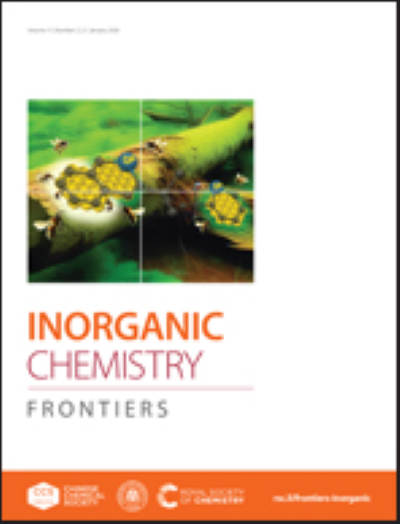[Sn3OF]PO4与[Sn3F3]PO4:通过打破R3对称性和重新排列孤对来增强双折射性
IF 6.4
1区 化学
Q1 CHEMISTRY, INORGANIC & NUCLEAR
引用次数: 0
摘要
含锡(II)的磷酸盐是设计和寻找具有增强双折射的材料的理想候选材料。在此,我们展示了一种新型[Sn3OF]PO4化合物,与近 40 年前发现的相关化合物[Sn3F3]PO4 相比,该化合物表现出显著的双折射(546 纳米波长处 ∆nobv = 0.117),提高了五倍。双折射的显著增强主要归功于各向同性的[SnO3F]5-结构构建单元。通过简单地调节 F/O 比,[Sn3F3]PO4 中不理想的 R3 对称性被打破。这种调节还能重新排列孤对,从而产生巨大的光学各向异性。本文章由计算机程序翻译,如有差异,请以英文原文为准。
![[Sn3OF]PO4vs. [Sn3F3]PO4: enhancing birefringence by breaking the R3 symmetry and realigning lone pairs†](https://img.booksci.cn/booksciimg/2024-7/98291903191753730354.jpg)
[Sn3OF]PO4vs. [Sn3F3]PO4: enhancing birefringence by breaking the R3 symmetry and realigning lone pairs†
Tin(II)-containing phosphates are promising candidates for designing and studying materials with enhanced birefringence. Herein, we present a novel compound [Sn3OF]PO4 that exhibits significant birefringence (Δnobv. = 0.117 at 546 nm), a five-fold improvement compared to that of the related compound [Sn3F3]PO4 discovered nearly 40 years ago. The remarkable enhancement in birefringence is primarily attributed to the anisotropic [SnO3F]5− structure building unit. By simple regulation of the F/O ratio, the undesirable R3 symmetry in [Sn3F3]PO4 is disrupted. This regulation also realigns the lone pairs, resulting in substantial optical anisotropy.
求助全文
通过发布文献求助,成功后即可免费获取论文全文。
去求助
来源期刊

Inorganic Chemistry Frontiers
CHEMISTRY, INORGANIC & NUCLEAR-
CiteScore
10.40
自引率
7.10%
发文量
587
审稿时长
1.2 months
期刊介绍:
The international, high quality journal for interdisciplinary research between inorganic chemistry and related subjects
 求助内容:
求助内容: 应助结果提醒方式:
应助结果提醒方式:


